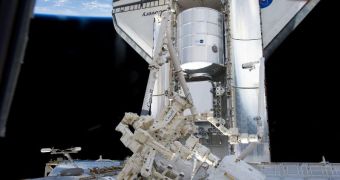The International Space Station just got a little bigger yesterday, as astronauts delivered and installed a new storage module on the orbital lab. The Permanent Multipurpose Module (PMM) will be used for depositing materials and supplies, and also for holding scientific and experiments equipment.
The storage room was delivered by the space shuttle Discovery, which made its way to the ISS on Saturday, February 26. After completing the first extravehicular activity of the mission, on February 28, the crew focused its attention on the PMM.
It was installed on an Earth-facing port of the Unity module that NASA designed and built. This is the last major addition that the American space agency will ever make to the facility.
The module was attached using the Dextre (Special Purpose Dexterous Manipulator) robotic arm, which was built by the Canadian Space Agency (CSA). The maneuver took place on March 1.
By 10:05 am EST (1505 GMT) yesterday, the module had been attached to the ISS. “Leonardo is looking very happy to be in his or her new home,” said ISS astronaut Catherine Coleman, of NASA.
The interior of the storage room has a volume of about 2,470 cubic feet (70 cubic meters), which will go a long way towards meeting ISS astronauts' demand for more storage space on the lab.
Leonardo is 21 feet (6.4 meters) long and 15 feet (4.5 meters) wide. Originally, it was a Multipurpose Logistics Module (MPLM), one of the three such containers that the Italian Space Agency (ISA) built for NASA, Space reports.
Each MPLM could weigh up to 28,353 pounds (12,860 kilograms) when fully loaded. The three modules – each of which is the size of a small bus – were used as sealed transport containers on several past shuttle missions.
Leonardo itself has been to space 7 times before. This is its eight and final mission. At this point, it carries about 6,500 pounds (2,900+ kilograms) of cargo, NASA says. After astronauts restore a habitable atmosphere within, they will begin unloading it.
Part of the payload is the Robonaut 2 android, which was developed by the American space agency in collaboration with General Motors. It will become a permanent ISS resident, and its mission is to assist human asteroids in performing tasks both inside and outside the station.
At this point, the 12 astronauts aboard the ISS and Discovery are getting ready for the second EVA of the STS-133 mission. Spacewalkers need to retrieve a broken ammonia pump that once powered one of the two loops in the station's cooling system.
It will be returned home aboard Discovery, for NASA engineers to test and diagnose. The experts are very curious as to what prompted the August 2010 malfunction that even brought about talks of evacuating the ISS.

 14 DAY TRIAL //
14 DAY TRIAL //